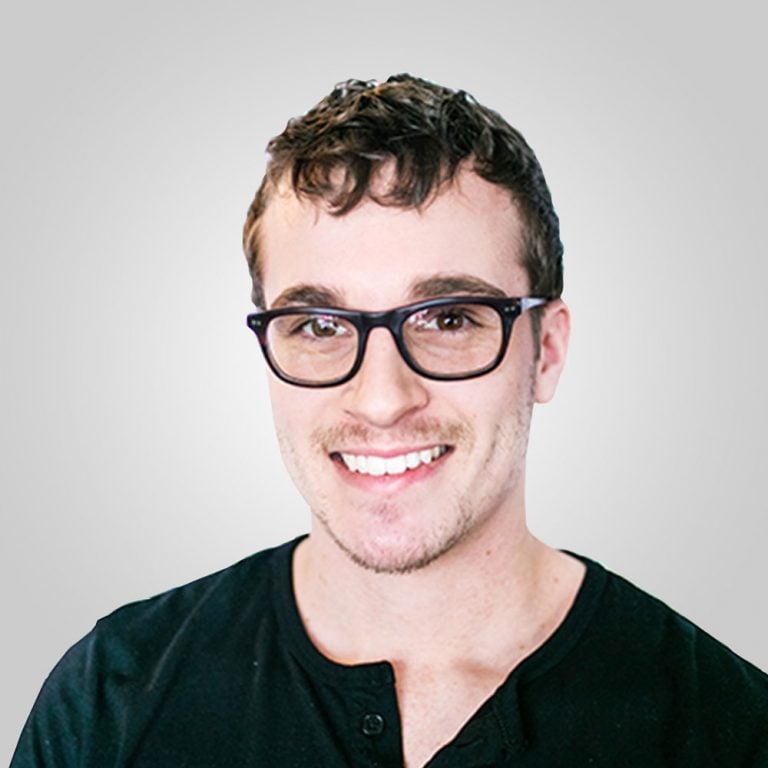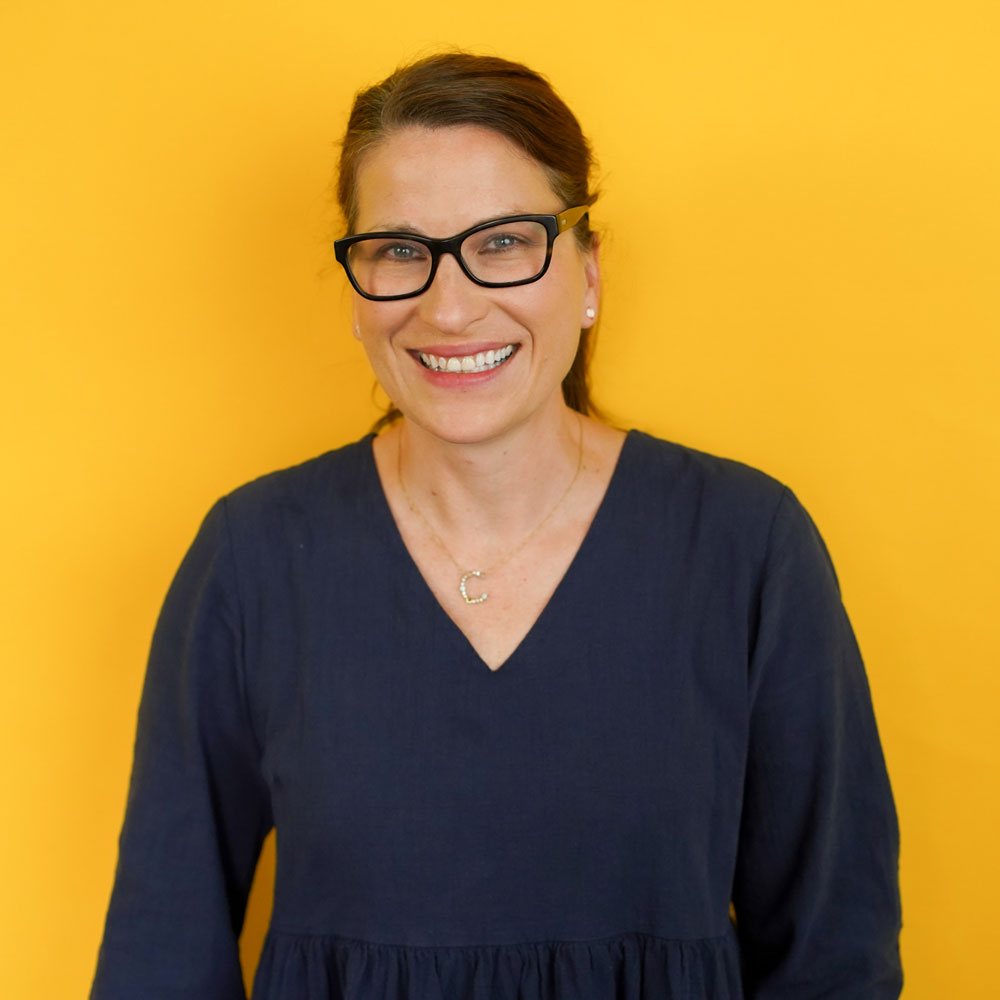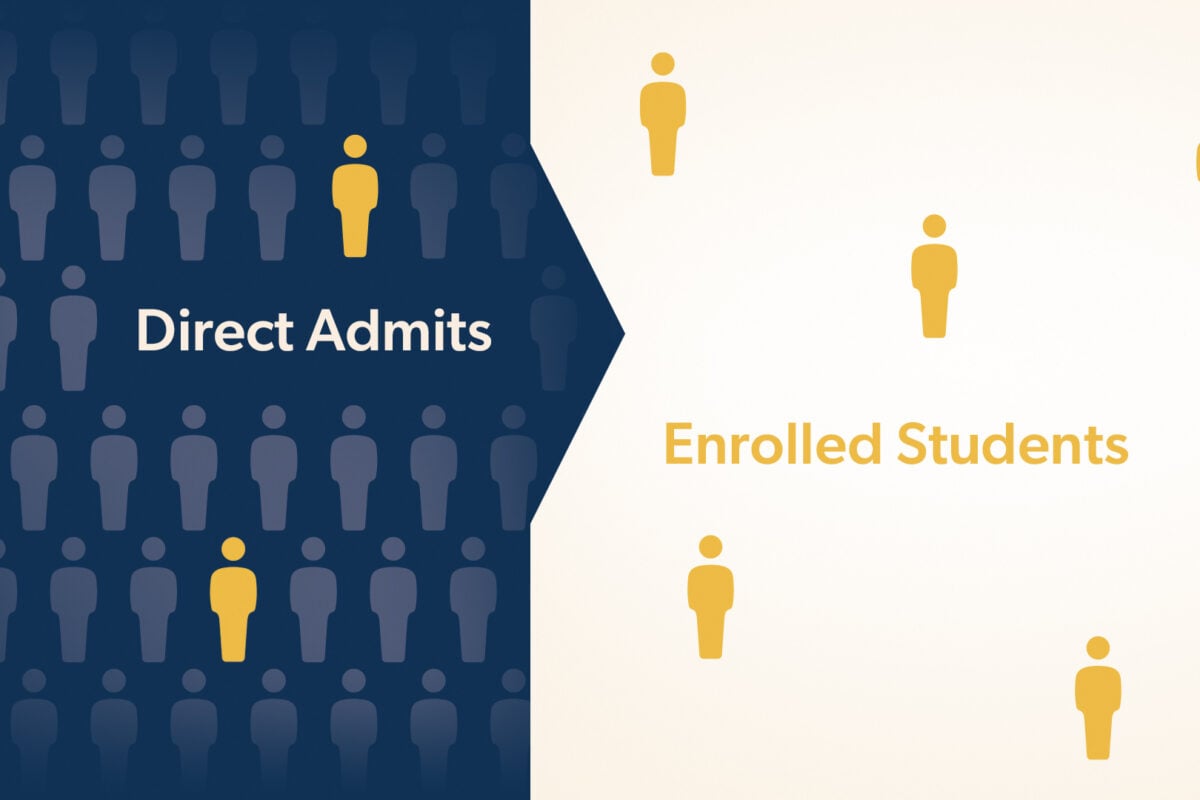In this episode of Innovating Enrollment Success, we cover how colleges and universities can start to maximize their schools’ findability and discoverability across the web.
Show Notes
Paskill’s Manager of Search Torin Keefer supports higher ed partners to improve their websites’ performance, user experience and discoverability in search.
He discusses a range of topics addressing SEO, including:
- understanding SEO in higher ed marketing today
- uncovering information opportunities and gaps
- implementing effective search strategies
- optimizing content to build experience, expertise, authority and trust
- demonstrating ROI of search strategies
Learn More About Our SEO Audit
Transcript
Cathy Donovan [00:00:00]
Hello, and welcome to the Innovating Enrollment Success podcast, where we talk about all the ways students are searching for and engaging with institutions on their higher ed journeys. Building brand affinity for any college or university starts much younger than the teen years. But when students do begin to seek out their options for higher learning, that is happening more and more online and on their terms.
The postcards and emails will still come and influence, but today we’ll be talking with an SEO expert on trends in online search and how institutions can better harness that knowledge in their marketing. I’m Cathy Donovan, agency marketing director at Paskill, a higher education enrollment marketing firm that connects the new and the established outreach strategies into our practice for partners across the country.
Today I’m joined by our agency’s manager of search, who in his work with higher ed helps improve website performance, user experience and SEO discoverability. Manager of Search Torin Keefer leads Paskill’s practice for higher ed partners. In the past five years, Torin’s work has been recognized with various awards, including Rookie of the Year for making an immediate impact.
Prior to joining Paskill, Torin worked for two other marketing agencies representing top customer brands and international clients. He was also a marketing intern and an art gallery attendant at his alma mater, Wilkes University. Welcome Torin.
Torin Keefer:
Excited to be here.
Cathy Donovan:
All right. So, let’s get started. For many listening, traditional higher ed search was about buying lists and marketing to prospective students with pretty predictable print and email schedules. The search you oversee, Torin focuses on the online trends of students starting their higher ed journeys at all hours and from all locations. If you could just give a little overview of the role in SEO higher ed marketing today.
Torin Keefer:
Yeah. So, I think the first thing that we should really kind of cover off on is, is what is SEO? What is “search” right? Okay, I think there’s this misnomer when it comes to SEO in terms of not really knowing what that means or what you’re getting out of it. And really at Paskill, we’re talking about search being the umbrella and SEO is a pillar that fits within that search umbrella, right?
So, search, when we’re talking about that, is the art and science of maximizing your findability and discoverability. For prospective students and families across all areas that they’re searching for information or engaging with content across the web. And really that search’s role is to try to find all of those areas in which they’re looking for that information, how your brand, how your institution can fit into those conversations.
Um, so specifically when we’re talking about SEO, we’re really focusing on organic search engines and how we can optimize that findability and discoverability within organic search specifically. That can come in the form, as you know, search has evolved to not just be traditional listings anymore.
It may include images and video carousels. It can be quick answers and people also ask accordions. It can be knowledge panels and local map packs. And now even with the emergence of AISGE search generative experience, there’s even more ways that you’re appearing within search and answering questions.
Queries directly within search, and there’s even other third-party directories that your, website may get scraped into that you also appear in that search can help to influence or control that information as well.
So, it’s really become a less linear path when we’re talking about SEO and really looking at this breadth, which is why we talk about it through the lens of search and this larger umbrella rather than just specifically SEO. But SEO is still absolutely a factor within that strategy. Now that all comes to fruition after, you know, conducting an audit, which is really where you start to uncover those opportunities, those gaps, and where the search strategy comes to life to start maximizing that findability and discoverability.
Cathy Donovan:
That is complex indeed. So, we know that SEO audits and data can really help an institution create this in-demand content and strengthen their paid campaigns and other marketing outreach. What are some of the challenges that you see universities and colleges face when they’re trying to implement some effective search strategies?
Torin Keefer:
This really spans the gamut when we’re talking about implementing the search strategies. And I think the biggest challenge that we often see in here is really just having the resources to support those programs, whether that’s from leadership or actually just the dollars to fund them as well.
There’s again, this educational piece that comes with it where it’s a buzzword, right? SEO. We know we need that for our website redesign. We know it’s important, but what does that mean? And sometimes from the top down, it’s not always clear what you’re going to be getting. So, it’s sometimes one of the first things that may get cut, but that’s again, where the educational piece comes in to help these institutions understand the value that you get out of a search strategy.
And it’s not just this check-the-box exercise. It’s really this living, breathing strategy to activate your brand, your institution’s presence across the web. We know, again, as it comes to website redesign, it’s crucial to have especially when you’re building a website from scratch or redoing what you have, you want to preserve your presence.
But in today’s competitive, organic world, you’re not just competing with other institutions or other local institutions, you’re competing with other websites that are organically competing with you across the web, and they may not even be other institutions, right? Um, so it’s this competitive game you’re playing and really looking to optimize your website to appear for the same search terms that these non-educational sites may also be optimizing for.
So how do you start to differentiate your website from these other ones, when you are an actual destination, an actual location that prospective students and families are going to want to potentially factor into their journey and their enrollment decision-making process, right?
So, this goes back to the larger search strategy we talked about with maximizing the ways in which you can be discovered in search and differentiate yourself within search. And with that differentiation, as I just mentioned, comes more time, more money, more resources to have to activate that kind of a strategy.
Oftentimes when we’re talking about that, it’s really going to come down to reputation and what we call “EEAT” factors within search. And that stands for experience, expertise, authority and trustworthiness within your website’s content and your website’s brand. The other big challenge we see outside of just, again, your living, breathing content of your website, is the challenge of demonstrating ROI.
So there’s this ongoing struggle within, you know, SEO and search sometimes where SEO can take time to, to really see the breadth of your, your investment, and the impact that it’s making, which again, can have, difficulties in getting the buy-in and really demonstrating that short term impact to decisionmakers and really showing that value.
But organic is a top converting channel. It’s just not as straightforward to demonstrate that ROI compared to, say, paid media campaigns that you spend so much. You have direct conversion metrics or application submissions, and you can justify that cost per click or cost per conversion in the immediate reporting.
So there’s definitely a challenge of demonstrating that value, even though organic is again, a channel that we see consistently as one of the top converting, but oftentimes that again coincides with these other campaigns. So. it shouldn’t be looked at as this siloed approach. It should really work together with your paid activations, your traditional marketing tactics, and really looking at this entire campaign as a living, breathing, approach and strategy. So that we’re taking into factor, how is this influencing this over here and how are these paid campaigns impacting our organic traffic coming to the site as well. And lastly, I would also say as well is the hurdle of implementation. You know, it’s the struggle that we see so many times with not even just higher ed clients, but specifically within higher ed, the review process, to actually get content under the website.
So again, when we’re talking about an optimization program over a period of time, you’re turning out more content, you’re turning out optimizations, but there’s many decisionmakers and stakeholders that are involved in this conversation to make sure it’s aligning with what their program is accredited to speak to and what it’s called.
And there might be a discrepancy in what we’re seeing prospective students search for that may not align with that accreditation title. So we have to find a way to bridge the gap between what programs may be called or what degrees may be called versus what prospective students are searching for, and how do we marry that within the content to appeal to both what can legally be said and also what prospective students or families are also searching for.
And then as we’re working through that process, it’s crucial in the upfront to make sure you’re aligning on timeline and outlining those expectations for review throughout the process so that the decisionmakers out at bay can also come through to map out what with our availability to review this content as well.
Cause again, what we’ll often see is we’re at the mercy of enrollment schedules, right? So, when we’re getting into key seasons or high enrollment periods, the availability isn’t always there and that can withhold and bottleneck the approval process. And if you aren’t getting optimizations implemented, you’re not demonstrating the impact that it’s making to the website.
You’re not getting the ROI and then you’re not showing value. So that doesn’t look good on anyone’s part. And that creates a, again, domino effect to just withhold more work and hold everything back.
Cathy Donovan:
Say an institution makes it through all those hurdles, you know, even then it’s work, right? Because if you’re a higher ed marketer at an institution, there’s so much data to process, and you’re also creating so much content across platforms for different audiences. When you have these elements in place, what are some good SEO metrics that folks should be paying attention to, to measure success, especially when it comes to enrollment?
Torin Keefer:
Sure. So, it’s, it’s definitely common to fall back and report on what we call vanity metrics within, within SEO or within search or even digital marketing as a whole, you know, those page views or sessions, those organic search clicks or impressions, even click through rate that you can get from Google search console.
But the problem with these metrics is they don’t demonstrate qualification of the users that are coming to your website. Are they prospective students? Are they engaging with your content on the website? Are they coming and not finding what they’re looking for and just leaving right away? You’re not getting that information from those top-level vanity metrics, right?
So really, it’s important to take a deeper level look at the data that you have available to you. And potentially that’s going to involve working with other stakeholders or working with other analytics professionals to make sure that these things are incorporated into their analytics or being tracked within their current platform.
And these again are things that we help identify during the auditing phase to make sure that the data that we’re working with is going to inform not only the future program as we work into the actual work itself, but for future demonstration of success as well. So, some of those metrics that we like to look at, or I was, I’ll say some of the, the data that we like to look at, particularly is when we’re talking about, again, organic is user pathways. Where are they going once they’re on the site? What content are they engaging with? Internal search terms is huge. So again, within search, we’re looking at the entire search experience from organic search engines all the way through to the website search experience.
What are they looking for once they’re on the website and then deeper into engagement. We’re always looking to understand dwell time and how long prospects are staying on the site or on a specific page. Where do they go? When do they leave? And those metrics can get granular into, again, average time on site, average time on page, pages per session, exit rate, bounce rate, even.
Now I always caveat bounce rate can be a misleading metric by itself. But it can also highlight opportunities for better tracking that may not adequately be set up in the current state so that might be, you know, things that we identify as there’s not proper links being tracked or form engagements or abandonment or scroll depth, which can all help trigger additional events that influence that bounce rate metric.
So, all together, these things start to paint a picture around not only the quality of your data, but also the quality of your website and how, how prospects are engaging with your content. And then outside of just specifically engagement, we do look at other SEO signals or metrics that help influence our campaign and what we look at from the success from a search perspective, which aren’t necessarily going to be impactful to users, but are impactful to us as SEOs to know how a website is performing health wise or otherwise within the digital ecosystem or organic ranking algorithm.
So those might entail, you know, share a voice or total ranking keywords to understand the breadth of your domain. How many keywords are ranking for both non branded and branded, um, domain authority or your domain strength. Again, this is going to be subjective to the platform of your choice. And also, total backlinks is also a good metric to be looking at just to understand are you getting mentions from other publications or other industry notable sources that are linking to your, to your web. Um, so these are just a few that we look at. Of course, there’s many that we’ll look at and it may be very specific to the institution and the, uh, sophistication of, of their data sets that they have available to them as well.
Cathy Donovan:
Great. A lot to process for sure. So, talk a little bit about local SEO’s role in attracting students to specific regions or campuses. You know, are there any good examples out there of local SEO strategies that are being implemented by some institutions?
Torin Keefer:
Yeah. Local SEO. That’s another one where, again, when we’re talking about search, there’s, there’s so much underneath that umbrella.
Local search is another pillar there. Um, so when we’re talking about search, you know, there’s, there’s the on-page content, there’s your technical SEO, there’s off page such as Google, my business being places, et cetera. That’s really where a lot of your local search optimization is going to fall into effect.
Optimizing for your local presence, um, specifically within your Google My Business and Bing Places, but also your knowledge panel. And that’s all influenced from a number of different factors on your website. So oftentimes if you are a multi-location or multi-center, um, institution, you want to make sure that you have dedicated pages for those locations, or at least schema markup on your website, to indicate that these are physical locations of other satellite campuses or otherwise locations of your institution to help inform those knowledge panels.
But also creating those corresponding Google My Business and Bing Places location listings so that you’re optimizing those listings to also appear within Google search, local map paths et cetera. So that when prospects or even current employees or faculty are looking for directions even to your campus, um, they can find that information quickly and available to them within the respective Apple maps, Google maps, whatever platform of choice they’re looking for directions or that information.
Um, and again, making sure the corresponding, uh, data is also in schema markup on the website as well. When it comes to good examples of that, um, again, spans the gamut. I, the first one that came to mind when, when, uh, you asked me this question was, uh, SNHU for some reason, um, they seem to just be the dominator of, of organic search within search results.
Now, I don’t believe that they have that many campuses. That could be wrong, but they just seem to be one that’s doing really well in the SEO space specifically, uh, when it comes to higher ed doing something right there.
Cathy Donovan:
Right. And it seems like while there’s an umbrella for SEO, um, it is about, about trust. So they, they relate. So if a user has a bad experience searching for directions or something, uh, that does impact their brand affinity. So it seems like they all do paint a picture of does this institution care about bringing people to its location?
Torin Keefer:
Absolutely. And more and more information is being pulled into those knowledge panels as well. You know, we’ve seen, um, for some of these larger institutions, uh, short-form videos being pulled in. Um, obviously there’s ratings and reviews of, you know, faculty or students of whomever that can also weigh in. There’s tuition information that can get pulled into these. All of this information really helps build out your knowledge panel that again at quick glance for prospective students or prospective families can gain so much knowledge about your institution before even making their way to your website.
Cathy Donovan:
Okay. Let’s talk about content marketing, which seems very relevant for higher ed partners, getting at that story that differentiates your brand and telling it for different channels, authentically and effectively. You know, how can schools create content that resonates with search and for prospective students? And I’m also curious how the relationship that exists, you know, it’s the content and the search and the search versus the content. So if you just want to talk a little bit about that.
Torin Keefer:
Yeah, I feel like there’s always been this, um, kind of head butting that’s been within the SEO space of like, which comes first, the chicken or the egg when it comes to content and SEO. Does SEO drive the content or does content drive the story and then SEO comes in to try to optimize it?
I don’t know that there’s an exact answer or science to that. I think it’s both. It really depends on the type of content that you’re creating and how it folds into your institution’s brand as well. Um, so for example, when we’re talking about, you know, academic content or enrollment information, that might not be something that’s specifically going to be a search-driven opportunity, but should be interlinked and viewed as, uh, secondary content to augment the prospective student’s journey throughout the website. Versus your program detail pages and potentially, blogs or article type of content that can dig into more specific queries or question intent, um, that, that is being searched by prospective students.
Um, now that’s going to be search-driven content that I would say SEO would drive, drive the strategy for. Um, now that’s to say, this all starts with research, right? So when we’re heading into a search program with the client, we’re really looking to understand how prospective students are searching for your programs or your institution, and leveraging that verbiage, not only within the content, but that may also trickle down into ad copy or brand messaging or what have you.
And that really comes down to the keyword research that we can do to understand the questions that are being asked, the terms, and those things that prospective students are looking for and mapping that out to the content needs, um, on the website or social media, wherever that may be, wherever that content needs to live again, under the umbrella of search, wherever prospective students or families are engaging with content, looking for that information, that’s really where we try to activate that.
But oftentimes that’s going to be living on your website. Cause that’s oftentimes the destination, right? And I will say too, there’s, there’s a merriment of this isn’t just a search effort, right? So at Paskill, we’re, we’re working directly with, with UX, we’re working with analytics, we’re working with content to really help understand and influence all of the factors that go into an experience on a website.
So with UX, it’s really important to be, you know, conducting interviews and user testing to get actual data around pain points and information. And once we have that information, we can start to, again, marry all this information together with search data, with UX research, with interviews and insights, and package all this into a robust strategy, a web strategy to activate, uh, all of that information appropriately across the web.
Cathy Donovan:
That gets at my next question, which is innovating enrollment success is obviously the name of this podcast and Paskill’s tagline. Can you tell me a little bit about what that might mean to you and your role at the agency?
Torin Keefer:
Yeah so I think kind of apparent through even just this discussion alone, you know, search is it’s ever-evolving, it’s constantly changing, it’s shape-shifting, it’s, you know, creating new ways to be discovered. And I think the biggest thing that, you know, we’re doing on the Paskill side is making sure that we’re constantly evolving and staying abreast of these trends to make sure that we’re not staying stagnant in what used to be traditional SEO.
I’m a firm believer if you were sticking in just the traditional optimization tactics, you’re being left in the dust, you’re not moving the needle, you’re not going to be impacting that prospective students’ experience when it comes to hired enrollment and looking for, um, you know, finding the information that you’re looking for again, back to discoverability and findability of your website.
Um, so I think really when it comes to innovating enrollment success, it’s all of those factors. It’s looking at the trends it’s working collaboratively with other departments to marry again, UX, SEO, analytics, content development, making sure that everything is working in step with one another. And that no one is competing against one another, but really we’re, we’re combining all of our strategies into a holistic, robust digital strategy underneath the same goal of just optimizing for that user, that prospective student, that prospective family.
Um, that’s how I see innovation happening. You’re, you’re getting a merriment of more ideas than just a single siloed effect. Um, you’re working together with everyone. So I think, you know, all of those things considered it takes a village.
Cathy Donovan:
That was well put. Well, thank you so much for joining me today. So how students search for colleges and information online will only quicken and expand. Getting a strategy in place can help institutions navigate this ever-changing marketplace. For more about Torin, see our show notes or find him on social. Or if you’d like, reach out to us at Paskill. We’d love to talk about how your school could improve its marketing through SEO.
Thanks so much.





